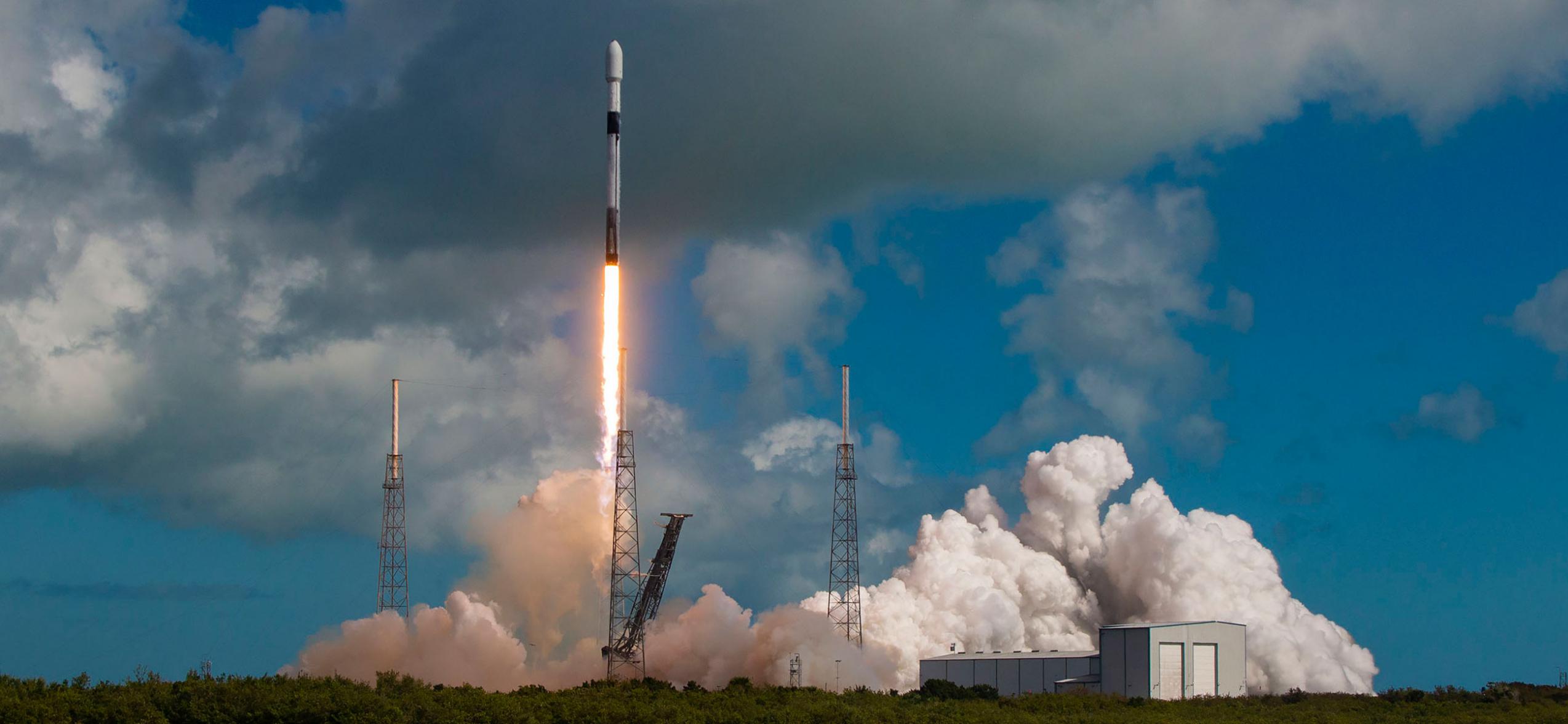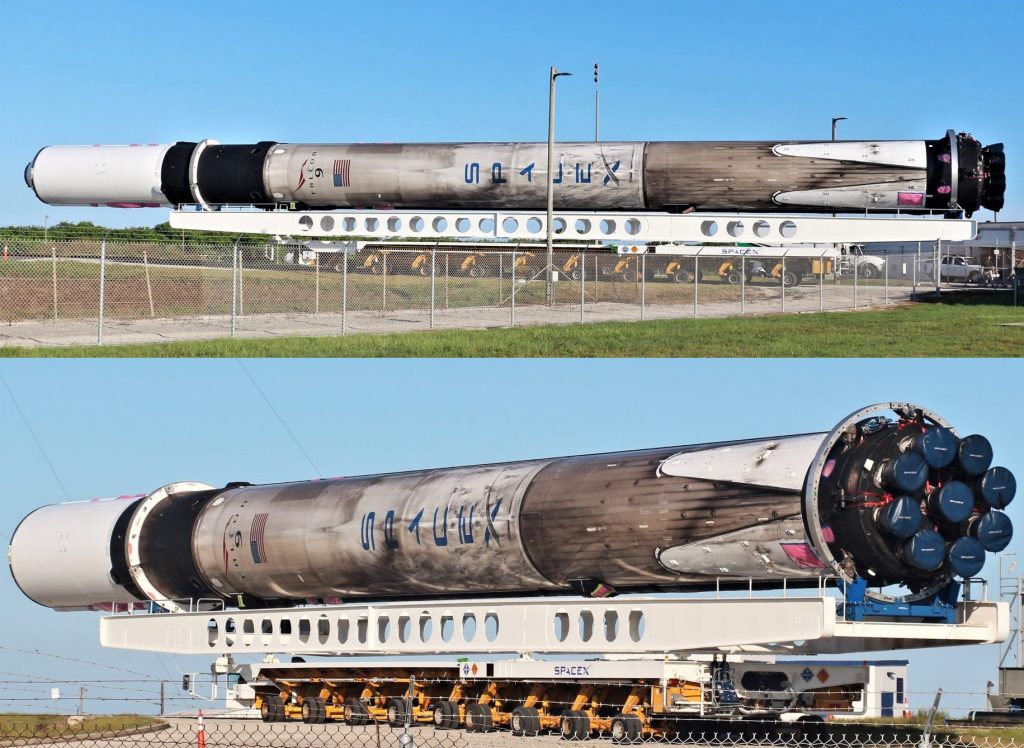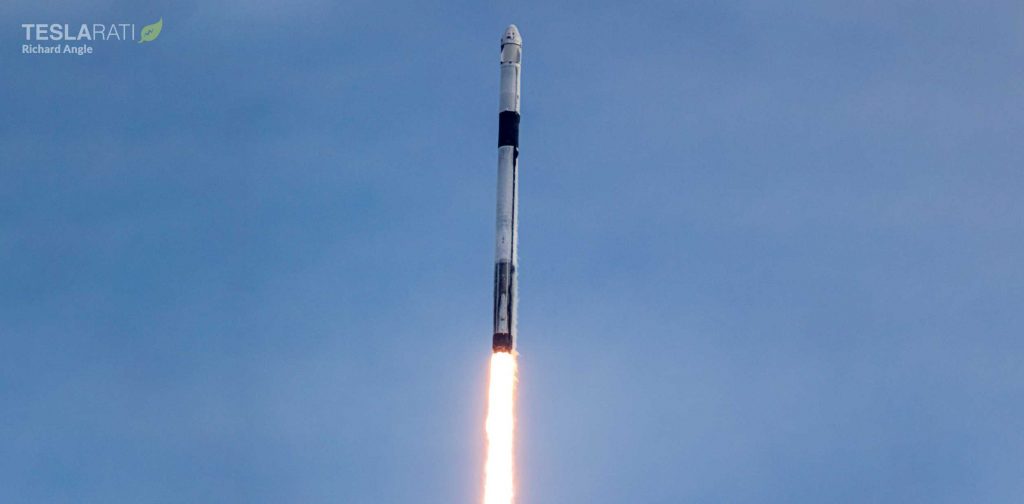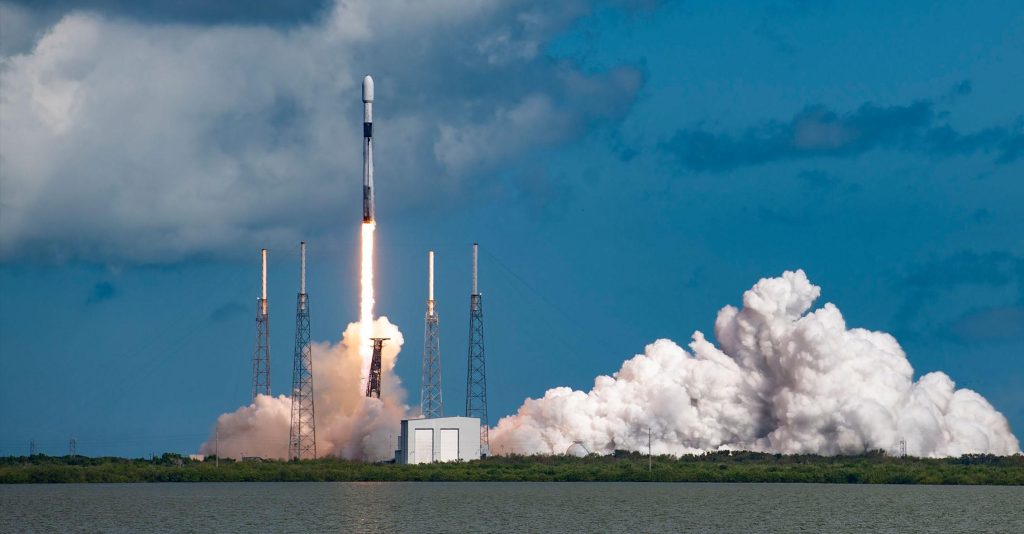

News
SpaceX expends Falcon 9 booster for the first time in almost three years
For the first time since January 2020, SpaceX has intentionally expended a Falcon 9 booster instead of attempting to recover the rocket at sea or on land.
Weighing around 6.6 tons (~14,600 lb) at liftoff, the rare mission sent Intelsat’s twin Maxar-built Galaxy 31 and 32 communications satellites to a high geostationary transfer orbit (GTO) that will allow them to start operating more quickly than a standard GTO would. To launch such a heavy payload to such a high ‘supersynchronous’ transfer orbit, SpaceX – at Intelsat’s request and for a fee – removed all landing-related hardware from Falcon 9 and did not attempt to recover the first stage.
Instead, the rocket put all the propellant that would have otherwise been saved for recovery into its first and only burn, reaching as high a speed as possible before separating from the second stage. Flying for the 14th time since its March 2019 debut, Falcon 9 booster B1051 didn’t perform a controlled flip or attempt to land on a SpaceX drone ship. It’s more likely that the few-dozen-ton rocket – now drained of propellant – reentered Earth’s atmosphere with no control at a speed of roughly 2.7 kilometers per second (~6000 mph), broke apart when it slammed into that atmospheric ‘wall,’ and crashed into the Atlantic Ocean as a cloud of debris.
Having already flown 13 times before its 14th and final mission, it’s safe to say that booster B1051 earned its permanent retirement as an artificial reef. The mission marked the first time a Falcon 9 booster was intentionally discarded since January 2020, when the first Falcon 9 Block 5 booster – B1046 – was destroyed as part of an intentional In-Flight Abort test of SpaceX’s Crew Dragon spacecraft.
Like B1046, B1051 was another fairly new Falcon 9 Block 5 booster. It’s no coincidence that most of the first five or so boosters have been or will be intentionally expended. B1047 was first in August 2019, followed by B1046 five months later, and B1051 in November 2022. B1048 and B1050 both suffered in-flight anomalies that – while they didn’t impact the success of their primary missions – resulted in failed landing attempts. After B1051’s demise, only B1049 remains. Next Spaceflight reports that SpaceX will also intentionally expend that booster after its 11th launch, which will send the Eutelsat 10B communications satellite to a different geostationary transfer orbit as early as this month..



While SpaceX likely charged its customers a healthy fee to expend B1049 and B1051, the company is likely not complaining about an opportunity to refine its fleet of Falcon boosters. Though no new variant has been officially introduced, SpaceX has learned more about the design over the years, and newer Falcon Block 5 boosters include improvements that make them easier and cheaper to operate and reuse. It’s also added four new Falcon 9 boosters to the fleet in less than a year, easing the burden created by expending two older but flightworthy boosters weeks apart.
Once B1049 is gone, that fleet will still have one unflown Falcon 9 booster, four unflown Falcon Heavy boosters, ten flown Falcon 9 boosters, and four flown Falcon Heavy side boosters – the latter of which can potentially be converted into Falcon 9 boosters during Falcon Heavy lulls. B1051 was the third Falcon 9 booster to complete 14 launches, meaning that SpaceX has gotten so good at routine reusability that it can safely assume that each new Falcon 9 Falcon Heavy side booster can fulfill the roles of more than a dozen expendable boosters.
Ultimately, B1051’s sacrifice left Falcon 9’s expendable upper stage with enough performance to boost Galaxy 31 and 32 into a supersynchronous orbit with an apogee more than 58,400 kilometers (~36,300 miles) above Earth’s surface – almost 1.5 times its circumference. Just last month, two recoverable Falcon 9 boosters helped launch a pair of smaller 4.5-ton (~10,000 lb) satellites to almost identical orbits (~57,500 km vs. ~58,400 km). Expending Falcon 9’s booster thus allowed SpaceX to launch almost 50% more payload to a similar supersynchronous GTO, demonstrating the substantial toll booster reuse incurs on launches to higher orbits.
Galaxy 31/32 was SpaceX’s 52nd launch this year and hit a target set by CEO Elon Musk in January. Musk later raised his goal to 60 launches, but SpaceX has managed an average of one Falcon launch every six days for nearly 12 months and has a strong shot at completing another eight launches before the end of the year.
News
Tesla cleared in Canada EV rebate investigation
Tesla has been cleared in an investigation into the company’s staggering number of EV rebate claims in Canada in January.

Canadian officials have cleared Tesla following an investigation into a large number of claims submitted to the country’s electric vehicle (EV) rebates earlier this year.
Transport Canada has ruled that there was no evidence of fraud after Tesla submitted 8,653 EV rebate claims for the country’s Incentives for Zero-Emission Vehicles (iZEV) program, as detailed in a report on Friday from The Globe and Mail. Despite the huge number of claims, Canadian authorities have found that the figure represented vehicles that had been delivered prior to the submission deadline for the program.
According to Transport Minister Chrystia Freeland, the claims “were determined to legitimately represent cars sold before January 12,” which was the final day for OEMs to submit these claims before the government suspended the program.
Upon initial reporting of the Tesla claims submitted in January, it was estimated that they were valued at around $43 million. In March, Freeland and Transport Canada opened the investigation into Tesla, noting that they would be freezing the rebate payments until the claims were found to be valid.
READ MORE ON ELECTRIC VEHICLES: EVs getting cleaner more quickly than expected in Europe: study
Huw Williams, Canadian Automobile Dealers Association Public Affairs Director, accepted the results of the investigation, while also questioning how Tesla knew to submit the claims that weekend, just before the program ran out.
“I think there’s a larger question as to how Tesla knew to run those through on that weekend,” Williams said. “It doesn’t appear to me that we have an investigation into any communication between Transport Canada and Tesla, between officials who may have shared information inappropriately.”
Tesla sales have been down in Canada for the first half of this year, amidst turmoil between the country and the Trump administration’s tariffs. Although Elon Musk has since stepped back from his role with the administration, a number of companies and officials in Canada were calling for a boycott of Tesla’s vehicles earlier this year, due in part to his association with Trump.
News
Tesla Semis to get 18 new Megachargers at this PepsiCo plant
PepsiCo is set to add more Tesla Semi Megachargers, this time at a facility in North Carolina.

Tesla partner PepsiCo is set to build new Semi charging stations at one of its manufacturing sites, as revealed in new permitting plans shared this week.
On Friday, Tesla charging station scout MarcoRP shared plans on X for 18 Semi Megacharging stalls at PepsiCo’s facility in Charlotte, North Carolina, coming as the latest update plans for the company’s increasingly electrified fleet. The stalls are set to be built side by side, along with three Tesla Megapack grid-scale battery systems.
The plans also note the faster charging speeds for the chargers, which can charge the Class 8 Semi at speeds of up to 1MW. Tesla says that the speed can charge the Semi back to roughly 70 percent in around 30 minutes.
You can see the site plans for the PepsiCo North Carolina Megacharger below.

Credit: PepsiCo (via MarcoRPi1 on X)

Credit: PepsiCo (via MarcoRPi1 on X)
READ MORE ON THE TESLA SEMI: Tesla to build Semi Megacharger station in Southern California
PepsiCo’s Tesla Semi fleet, other Megachargers, and initial tests and deliveries
PepsiCo was the first external customer to take delivery of Tesla’s Semis back in 2023, starting with just an initial order of 15. Since then, the company has continued to expand the fleet, recently taking delivery of an additional 50 units in California. The PepsiCo fleet was up to around 86 units as of last year, according to statements from Semi Senior Manager Dan Priestley.
Additionally, the company has similar Megachargers at its facilities in Modesto, Sacramento, and Fresno, California, and Tesla also submitted plans for approval to build 12 new Megacharging stalls in Los Angeles County.
Over the past couple of years, Tesla has also been delivering the electric Class 8 units to a number of other companies for pilot programs, and Priestley shared some results from PepsiCo’s initial Semi tests last year. Notably, the executive spoke with a handful of PepsiCo workers who said they really liked the Semi and wouldn’t plan on going back to diesel trucks.
The company is also nearing completion of a higher-volume Semi plant at its Gigafactory in Nevada, which is expected to eventually have an annual production capacity of 50,000 Semi units.
Tesla executive teases plan to further electrify supply chain
News
Tesla sales soar in Norway with new Model Y leading the charge
Tesla recorded a 54% year-over-year jump in new vehicle registrations in June.

Tesla is seeing strong momentum in Norway, with sales of the new Model Y helping the company maintain dominance in one of the world’s most electric vehicle-friendly markets.
Model Y upgrades and consumer preferences
According to the Norwegian Road Federation (OFV), Tesla recorded a 54% year-over-year jump in new vehicle registrations in June. The Model Y led the charge, posting a 115% increase compared to the same period last year. Tesla Norway’s growth was even more notable in May, with sales surging a whopping 213%, as noted in a CNBC report.
Christina Bu, secretary general of the Norwegian EV Association (NEVA), stated that Tesla’s strong market performance was partly due to the updated Model Y, which is really just a good car, period.
“I think it just has to do with the fact that they deliver a car which has quite a lot of value for money and is what Norwegians need. What Norwegians need, a large luggage space, all wheel drive, and a tow hitch, high ground clearance as well. In addition, quite good digital solutions which people have gotten used to, and also a charging network,” she said.
Tesla in Europe
Tesla’s success in Norway is supported by long-standing government incentives for EV adoption, including exemptions from VAT, road toll discounts, and access to bus lanes. Public and home charging infrastructure is also widely available, making the EV ownership experience in the country very convenient.
Tesla’s performance in Europe is still a mixed bag, with markets like Germany and France still seeing declines in recent months. In areas such as Norway, Spain, and Portugal, however, Tesla’s new car registrations are rising. Spain’s sales rose 61% and Portugal’s sales rose 7% last month. This suggests that regional demand may be stabilizing or rebounding in pockets of Europe.
-

 Elon Musk2 weeks ago
Elon Musk2 weeks agoTesla investors will be shocked by Jim Cramer’s latest assessment
-

 Elon Musk2 days ago
Elon Musk2 days agoxAI launches Grok 4 with new $300/month SuperGrok Heavy subscription
-

 Elon Musk4 days ago
Elon Musk4 days agoElon Musk confirms Grok 4 launch on July 9 with livestream event
-

 News1 week ago
News1 week agoTesla Model 3 ranks as the safest new car in Europe for 2025, per Euro NCAP tests
-

 Elon Musk2 weeks ago
Elon Musk2 weeks agoA Tesla just delivered itself to a customer autonomously, Elon Musk confirms
-

 Elon Musk1 week ago
Elon Musk1 week agoxAI’s Memphis data center receives air permit despite community criticism
-

 News2 weeks ago
News2 weeks agoXiaomi CEO congratulates Tesla on first FSD delivery: “We have to continue learning!”
-

 News2 weeks ago
News2 weeks agoTesla sees explosive sales growth in UK, Spain, and Netherlands in June

















